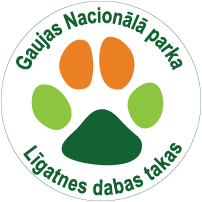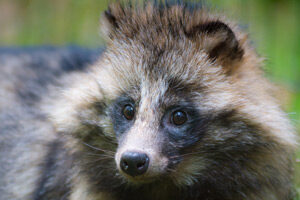Where do they live? Raccoon dogs mainly occur in moist mixed and deciduous forests near swamps, lakes or rivers, in the coastal areas of different water bodies, shrub-covered alluvial meadows, grass marshlands and borders of other marshy areas. They select abandoned badger or fox burrows as their winter dwellings, as well as they dig their own burrows or use natural hiding places.
How do they live? The smallest canine of Latvia is not only a loving and faithful partner to their mate, but also to their inhabited territory. Raccoon dogs choose their partners for life and do almost everything together – seek food, walk, rest, raise their offspring and even overwinter! Raccoon dogs are the only canines that hibernate in winter. They spend the cold winter months, most commonly - from November to March, in an inactive state, which can be described as partial hibernation. During this period they feed on the accumulated fat reserves. However, when the snow melts, on warm days, they may wake up and go in search of food. Probably, their hibernation can be explained by the low height of the raccoon dogs and short legs, which make mobility and the search for food (hunting) inconvenient in winter with deep snow.
What do they eat? Although categorised as predators, these animals are proper omnivores and their menu changes depending on the season. Most of their menu consists of mice-like rodents, insects, amphibians, birds nesting on the ground, eggs, fruit and berries. They are also fond of agricultural crops like oats, corn, pumpkins and other greens.
Did you know?
- Raccoon dog is the smallest representative of the canine family in Latvia.
- Raccoon dogs have five subspecies.
- The fur on the raccoon dog on their face resembles a “mask” – with a white muzzle, white “sideburn” and dark areas around the eyes.
- In danger, raccoon dogs tend to pretend that they are dead, cling to the ground, close their eyes and freeze. Thus, raccoon dogs can be easily caught alive. Sometimes raccoon dogs produce an exceptionally unpleasant stench to scare the attacker away.
- Raccoon dogs were officially introduced to Latvia in 1948, however, there are records that they have been noticed as early as in 1943. The natural range of raccoon dogs is East Asia. Raccoon dogs were introduced here with the purpose of expanding the range of game animals.
- In contrast to other canines, raccoon dogs do not bark properly – they produce a variety of other sounds instead.
- Actually, raccoon dogs are omnivores, whose menu changes depending on the season.
- Raccoon dogs are very clean and tidy – they establish toilets in a certain place and all the group of raccoon dogs use this place to leave their urine and faeces. Toilets play a significant role in the social life, mutual communication and contacts of these animals.
- Raccoon dogs are highly susceptible to scabies and rabies - can serve as a vector for the spread of these diseases.
- Raccoon dogs choose the partners to live with as a couple for life and do almost everything together – seek food, walk, rest, raise their offspring and even pass the winter.
- Raccoon dogs are the only canines that hibernate in winter. They spend the cold winter months, most commonly - from November to March, in an inactive state, which can be described as partial hibernation, when they feed on the accumulated fat reserves. Probably, their hibernation can be explained by the low height of the raccoon dogs and short legs, which make mobility, and the search (and hunting) for food inconvenient in winter with deep snow.
- Raccoon dogs are frequently mistaken for raccoons. Racoon dogs and raccoons are two different species of animals. Raccoons live in America and climb trees. The tail of a raccoon dog is short and has a comparatively homogeneous colouring, meanwhile that of a raccoon is longer and striped.
- Raccoon dog raises its tail in a reverse U shape to demonstrate dominance.
- Racoon dogs have untypical small teeth, if compared with other canines.
- Raccoon dog or Tanuki is an important character in Japanese culture, where it is pictured as a mischievous master of masking and disguise, sometimes also being naive and forgetful. Statues of Tanuki can be seen next to many temples and restaurants in Japan. Tanuki occurs as a character in many films and video games.
- The scientific name of the racoon dog has originated from the Greek (“nycto” - night and “ereutes” - wanderer) and means “night wanderer”.

